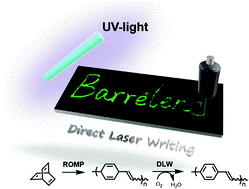Bielawski and co-workers report the ROMP of barrelene monomer affording precisely defined fluorescent patterns with micrometer-sized dimensions.
Conjugated polymers have attracted considerable attention owing to their abilities to form films and exhibit high electrical conductivities and as such they have found use in a range of electronic and optical applications. Amongst the various types of polymers, poly(phenylene vinylene) (PPV) is an excellent candidate due to its low optical band gap, large nonlinear optical response, and emissive properties. However, this material is typically intractable and thus challenging to process. To overcome this, Bielawski and co-workers designed a new approach to PPV was through the ring-opening metathesis polymerization (ROMP) of “barrelene” (bicyclo[2.2.2]octa-2,5,7-triene). The monomer was characterized for the first time by X-ray diffraction analysis of a coordination complex. Barrelene was subsequently homopolymerized and copolymerized with norbornene. The solubility of barrelene homopolymers was found to depend on the cis to trans ratio of alkene in its backbone. Both the homo and copolymers were transformed to PPV by undergoing spontaneous dehydrogenation under air. The materials were analyzed by a range of spectroscopic techniques. Importantly, direct laser writing of the barrelene-containing copolymers was also demonstrated resulting in thermal aromatization within a few seconds affording precisely defined fluorescent patterns with micrometer-sized dimensions. An intrinsic advantage of this development is that the monomer can be potentially incorporated into different macromolecular scaffolds and at varying compositions. Owing to this unique characteristic, the authors envision that their designed strategy would enable the synthesis of a broad range of materials for use in laser machining and contemporary lithography applications.
Tips/comments directly from the authors:
1) The solubility of poly(barrelene) is dependent on the cis-to-trans ratio of the exocyclic olefins in the polymer backbone. Polymers with relatively high cis olefin contents appear to be more soluble than their trans isomers.
2) The resolution of the patterns created by direct laser writing appear to be inversely proportional to the barrelene content of the copolymer used and may be enhanced further by increasing the transparency of the films.
3) Poly(barrelene) oxidizes in air (slow) or upon laser irradiation (fast). A convenient way to monitor the oxidation reaction is through fluorescence spectroscopy. The starting material is non-emissive whereas the poly(phenylene vinylene) product emits a fluorescent green color upon excitation.
4) Because barrelene is strained, copolymerization with other monomers used in ring-opening metathesis polymerization methodologies can be expected which, in turn, may expand the utility of the direct laser writing technique.
Citation to the paper: Direct laser writing of poly(phenylene vinylene) on poly(barrelene), Polym. Chem., 2020, 11, 5437-5443, DOI: 10.1039/d0py00869a
Link to the paper:
https://pubs.rsc.org/en/content/articlepdf/2020/py/d0py00869a
 Dr. Athina Anastasaki is an Editorial Board Member and a Web Writer for Polymer Chemistry. Since January 2019, she joined the Materials Department of ETH Zurich as an Assistant Professor to establish her independent research group.
Dr. Athina Anastasaki is an Editorial Board Member and a Web Writer for Polymer Chemistry. Since January 2019, she joined the Materials Department of ETH Zurich as an Assistant Professor to establish her independent research group.











